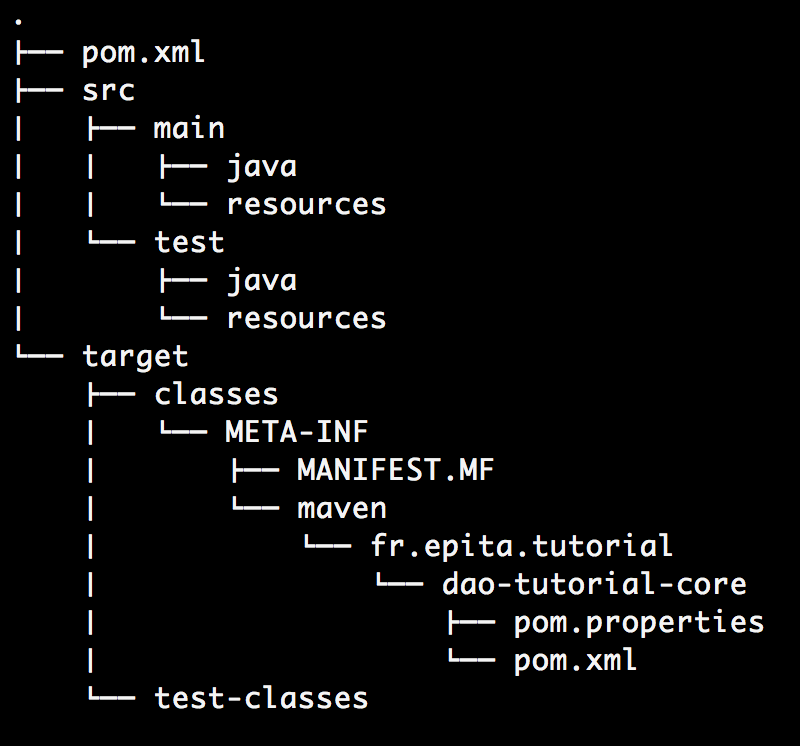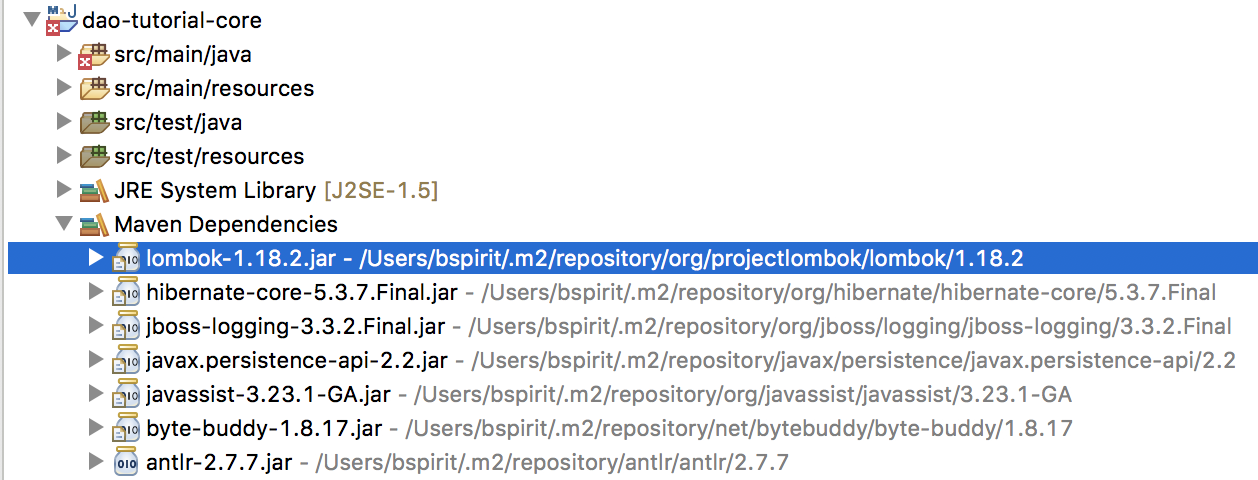This page has been fully written by
Tony Clonier
and validated by Thomas Broussard
The purpose of this tutorial is to implement the DAO design pattern using Java and the JPA API.
All of the following code can be found in my public repository:
https://bitbucket.org/BSpirit/dao-tutorial-core/src/master/
Project Set up
In this part, we are going to set up the Java project using Eclipse IDE and Apache Maven software.
Tools
- Eclipse IDE
Eclipse is a popular IDE used in Java programming.
https://www.eclipse.org/downloads/
- Maven
Apache Maven is a software project management and comprehension tool. Based on the concept of a Project Object Model (POM), Maven can manage a project’s build, reporting and documentation from a central piece of information.
Its main purpose for this tutorial will be to handle dependencies between librairies.
Create new project
Open Eclipse IDE and create a new Maven Project: File -> New -> Maven Project
- You may check
Create a simple projectoption. This will create a basic, Maven-enabled Java project. If you require a more advanced setup, leave this setting unchecked, and you will be able to use more advanced Maven project setup features. Then, clicknext. - Fill up new project informations, then click
finish.

- The structure of a Maven Based project is as follow:

Adding dependencies
The dependencies of the project can be found in the pom.xml file located at the root of the project. To begin with, we are going to add Lombok and Hibernate dependencies:
- include lombok, add it to your
<dependencies>block like so:
<dependency>
<groupId>org.projectlombok</groupId>
<artifactId>lombok</artifactId>
<version>1.18.2</version>
<scope>provided</scope>
</dependency>
- To include Hibernate, add it to your
<dependencies>block like so:
<dependency>
<groupId>org.hibernate</groupId>
<artifactId>hibernate-core</artifactId>
<version>5.3.7.Final</version>
</dependency>
- To force the project to compile using Java 8, you should also add this:
<properties>
<maven.compiler.source>1.8</maven.compiler.source>
<maven.compiler.target>1.8</maven.compiler.target>
</properties>
- Your final
pom.xmlfile should look like this:
<project xmlns="http://maven.apache.org/POM/4.0.0"
xmlns:xsi="http://www.w3.org/2001/XMLSchema-instance"
xsi:schemaLocation="http://maven.apache.org/POM/4.0.0
http://maven.apache.org/xsd/maven-4.0.0.xsd">
<modelVersion>4.0.0</modelVersion>
<groupId>fr.epita.tutorial</groupId>
<artifactId>dao-tutorial-core</artifactId>
<version>0.0.1-SNAPSHOT</version>
<name>dao-tutorial-core</name>
<properties>
<maven.compiler.source>1.8</maven.compiler.source>
<maven.compiler.target>1.8</maven.compiler.target>
</properties>
<dependencies>
<dependency>
<groupId>org.projectlombok</groupId>
<artifactId>lombok</artifactId>
<version>1.18.2</version>
<scope>provided</scope>
</dependency>
<dependency>
<groupId>org.hibernate</groupId>
<artifactId>hibernate-core</artifactId>
<version>5.3.7.Final</version>
</dependency>
</dependencies>
</project>
- Once the dependency is added, you must use
maven installcommand to set the project. In eclipse, you can right click on thepom.xmlfile located at the root of the project and go toRun As -> Maven install.
NOTE: When adding new dependencies, you may right click on the root of the project and go to Maven -> Update Project to get the new dependencies.
Lombok installation
- Once the jar was downloaded in your local repository, go to the jar location from command prompt. If you are not sure where to find it, the path is specified in Eclipse:

- Then use
java -jar lombok-1.18.2.jarto pursue Lombok installation. You may have to restart Eclipse.
Entities
Entities are POJO (Plain Old Java Object) class whose main purpose is to be mapped to relationnal database tables. In this part of the tutorial, we will use JPA API (thanks to Hibernate) and Lombok to easily create Entity classes.
Tools
- Project Lombok
Project Lombok is a java library that automatically plugs into your editor and build tools, spicing up your java.
- Hibernate
Java Persistence API purpose is to persistently store the vast amounts of data into a database. Using JPA, the burden of interacting with the database reduces significantly. It forms a bridge between object models (Java program) and relational models (database program).
In this tutorial, we will use Hibernate ORM, as it is also an implementation of the Java Persistence API (JPA) specification.
Let’s write some code !
To illustrate the DAO design pattern, we are first going to create two entities, an Author entity and a Book entity. Using Javax.persistence and Lombok, the code is very simple.
- First, let’s create our Author class inside a
fr.epita.tutorial.datamodelpackage. Right click onsrc/main/javaand go tonew -> Class.

The code of the Author class is as simple as this !
@Entity
@Data
public class Author {
@Id
@GeneratedValue(strategy=GenerationType.AUTO)
private Long id;
private String firstName;
private String lastName;
}
The code of the Book class is as easy to write:
@Entity
@Data
public class Book {
@Id
@GeneratedValue(strategy=GenerationType.AUTO)
private Long id;
In these examples, several annotations are used to avoid writing redundant code:
Datais a Lombok annotation and allows auto generation of setters/getters and other utilities function such astoString,hashCodeorequalsEntityis used to create the binding between our class and the DB tableIdis used to specify which attribut is used as an ID inside the DB tableManyToOneis used to specify the relation between our Book class and our Author class (this will also impact the DB tables)
3. DAO
The Data Access Object (DAO) pattern is a structural pattern that allows isolation of the application/business layer from the persistence layer (usually a relational database, but it could be any other persistence mechanism) using an abstract API.
The functionality of this API is to hide from the application all the complexities involved in performing CRUD operations in the underlying storage mechanism. This permits both layers to evolve separately without knowing anything about each other.
In this part of the tutorial, we will create simple DAOs allowing an easy access to our DB entities. We will also use dependency injection to help us instanciate the DriverManagerDataSource and the SessionFactory objects, which are both necessary to handle the DB connection.
Tools
- Log4j
Apache Log4j is a Java-based logging utility. It can be used to help debugging the application if necessary. It can be added as a maven dependency by updating your pom.xml file:
<dependency>
<groupId>org.apache.logging.log4j</groupId>
<artifactId>log4j-api</artifactId>
<version>2.11.1</version>
</dependency>
<dependency>
<groupId>org.apache.logging.log4j</groupId>
<artifactId>log4j-core</artifactId>
<version>2.11.1</version>
</dependency>
To use Log4j, you have to create a configuration file. Create a file called log4j2.xml in src/test/resources/ and add this content:
<?xml version="1.0" encoding="UTF-8"?>
<Configuration status="WARN">
<Appenders>
<Console name="Console" target="SYSTEM_OUT">
<PatternLayout
pattern="%d{HH:mm:ss.SSS} [%t] %-5level %logger{36} - %msg%n"/>
</Console>
</Appenders>
<Loggers>
<Root level="info">
<AppenderRef ref="Console"/>
</Root>
</Loggers>
</Configuration>
https://logging.apache.org/log4j/2.x/
- Spring Framework
The Spring Framework is an application framework. In this part of the tutorial, it will be used for dependency injection using Inject annotation from javax.inject. These can be added as maven dependencies by updating your pom.xml file:
<dependency>
<groupId>javax.inject</groupId>
<artifactId>javax.inject</artifactId>
<version>1</version>
</dependency>
<dependency>
<groupId>org.springframework</groupId>
<artifactId>spring-test</artifactId>
<version>5.0.9.RELEASE</version>
<scope>test</scope>
</dependency>
<dependency>
<groupId>org.springframework</groupId>
<artifactId>spring-core</artifactId>
<version>5.0.9.RELEASE</version>
</dependency>
<dependency>
<groupId>org.springframework</groupId>
<artifactId>spring-context</artifactId>
<version>5.0.9.RELEASE</version>
</dependency>
<dependency>
<groupId>org.springframework</groupId>
<artifactId>spring-orm</artifactId>
<version>5.0.9.RELEASE</version>
</dependency>
Let’s write some code !
- First, let’s create, inside a
fr.epita.tutorial.datamodelpackage, a generic DAO able to perform basic CRUD operations. Right click onsrc/main/javaand go tonew -> Class. The DAO code is as follow:
public abstract class DAO<T> {
protected static final Logger LOGGER = LogManager.getLogger(DAO.class);
protected Class<T> modelClass;
@Inject
@Named("sessionFactory")
private SessionFactory sf;
public void setmodelClass(Class<T> modelClass) {
this.modelClass = modelClass;
}
protected final Session getSession() {
Session session = null;
try {
session = this.sf.getCurrentSession();
} catch (Exception e) {
LOGGER.error(e);
}
if (session == null)
session = sf.openSession();
return session;
}
protected final Transaction getTransaction(Session session) {
Transaction tx = session.getTransaction();
if (!TransactionStatus.ACTIVE.equals(tx.getStatus()))
tx = session.beginTransaction();
return tx;
}
public final Long create(T obj) {
Session session = this.getSession();
Transaction tx = this.getTransaction(session);
Long id = (Long) session.save(obj);
tx.commit();
return id;
}
public final void delete(T obj) {
Session session = this.getSession();
Transaction tx = this.getTransaction(session);
session.delete(obj);
tx.commit();
}
public final void update(T obj) {
Session session = this.getSession();
Transaction tx = this.getTransaction(session);
session.update(obj);
tx.commit();
}
public T getById(Long id) {
return getSession().get(modelClass, id);
}
@SuppressWarnings("unchecked")
public List<T> getAll() {
return getSession().createQuery("from " +
modelClass.getName()).list();
}
public abstract List<T> search(T criteria);
}
In the previous exemple:
- The
SessionFactoryobject is used to create Sessions and Transactions with the DB. We will see later how to configure it. getSessionandgetTransactionmethods are used to avoid Sessions or Transactions duplication.create,update,update,getByIdandgetAllmethods perform the basic CRUD actions. As you can, we don’t even need to know what the data looks like thanks to genericity.
Because this DAO class is abstract, it cannot be instantiated. Specific DAOs must be created for each entity and can be used to specify some behaviors, which might depends on the entity itself:
- AuthorDAO:
@Repository
public class AuthorDAO extends DAO<Author> {
public AuthorDAO() {
this.setmodelClass(Author.class);
}
@Override
public List<Author> search(Author criteria) {
String searchQuery = "from Author as a " +
"where a.firstName like :firstName or " +
"a.lastName like :lastName";
Session session = this.getSession();
Query<Author> query = session.createQuery(searchQuery, Author.class);
query.setParameter("firstName", "%" + criteria.getFirstName() + "%");
query.setParameter("lastName", "%" + criteria.getLastName() + "%");
return query.list();
}
}
- BookDAO:
@Repository
public class BookDAO extends DAO<Book> {
public BookDAO() {
this.setmodelClass(Book.class);
}
@Override
public List<Book> search(Book criteria) {
String searchQuery = "from Book where author = :author";
Query<Book> query = getSession().createQuery(searchQuery, Book.class);
query.setParameter("question", criteria.getAuthor());
return query.list();
}
}
In the previous examples:
- We use a create a query using HQL (Hibernate Query Language) and the
Queryobject. - We use
setParameterto make a binding using the criteria variable. - We return the result of the
Queryas a list. - The @Repository annotation is needed by Spring Framework when creating a DAO class. For more details, check Spring Framework documentation.
Use dependency injection
The BookDAO and AuthorDAO are both using dependency injection to instantiate the SessionFactory object. As a result, these objects have to be managed by the Spring IoC container. These objects can be refered as «beans». These beans are created with the configuration metadata supplied, for example using an XML file.
Let’s create this XML file:
- Create a file called
applicationContext.xmlinsrc/test/resourcesand add this content inside:
<beans xmlns="http://www.springframework.org/schema/beans"
xmlns:xsi="http://www.w3.org/2001/XMLSchema-instance"
xmlns:context="http://www.springframework.org/schema/context"
xmlns:mvc="http://www.springframework.org/schema/mvc"
xsi:schemaLocation="http://www.springframework.org/schema/beans
http://www.springframework.org/schema/beans/spring-beans.xsd
http://www.springframework.org/schema/context
http://www.springframework.org/schema/context/spring-context.xsd
http://www.springframework.org/schema/mvc
http://www.springframework.org/schema/mvc/spring-mvc.xsd">
<context:component-scan
base-package="fr.epita.tutorial.services.data"/>
<bean id="dataSource"
class="org.springframework.jdbc.datasource.DriverManagerDataSource">
<property
name="url"
value="jdbc:h2:mem:test;DB_CLOSE_DELAY=-1">
</property>
<property
name="username"
value="test">
</property>
<property
name="password"
value="test">
</property>
<property
name="driverClassName"
value="org.h2.Driver">
</property>
</bean>
<bean id="hibernateProperties"
class="org.springframework.beans.factory.config.PropertiesFactoryBean">
<property name="properties">
<props>
<prop key="hibernate.dialect">
org.hibernate.dialect.H2Dialect
</prop>
<prop key="hibernate.show_sql">
true
</prop>
<prop key="hibernate.hbm2ddl.auto">
update
</prop>
<prop key="hibernate.connection.autocommit">
false
</prop>
</props>
</property>
</bean>
<bean id="sessionFactory"
class="org.springframework.orm.hibernate5.LocalSessionFactoryBean">
<property
name="dataSource"
ref="dataSource" />
<property
name="hibernateProperties"
ref="hibernateProperties" />
<property
name="packagesToScan">
<list>
<value>fr.epita.tutorial.datamodel</value>
</list>
</property>
</bean>
</beans>
Let’s explain this configuration a little bit more:
<context:component-scan base-package="fr.epita.tutorial.services.data" />is used to scan the given package in order to make theBookDAOandAuthorDAOclasses recognizable as Beans and injected.<bean id="sessionFactory" class="org.springframework.orm.hibernate5.LocalSessionFactoryBean">is used to instantiate theSessionFactoryobject.- This Bean need both
dataSource@and @hibernatePropertiesto be instantiated.
4. Tests with JUnit
In this session, we are going to use JUnit to test some of the CRUD operations and demonstrate how dependency injection works.
Tools
- H2 Database
H2 is a relational database management system written in Java. It can be embedded in Java applications or run in the client-server mode. It will be used to store our data. It can be added as a maven dependency by updating your pom.xml file:
<dependency>
<groupId>com.h2database</groupId>
<artifactId>h2</artifactId>
<version>1.4.197</version>
<scope>test</scope>
</dependency>
http://www.h2database.com/html/main.html
- JUnit
JUnit framework will be used for unit tests. It can be added as a maven dependency by updating your pom.xml file:
Let’s write some code !
- Let’s create some tests inside a
fr.epita.tutorial.services.testpackage. Right click onsrc/test/javaand go tonew -> Class. The code is as follow:
@RunWith(SpringJUnit4ClassRunner.class)
@ContextConfiguration(locations = "/applicationContext.xml")
public class TestJPA {
private static final Logger LOGGER = LogManager.getLogger(TestJPA.class);
@Inject
AuthorDAO authorDAO;
@Inject
BookDAO bookDAO;
@Before
public void addAuthor() {
Author author = new Author();
author.setFirstName("Philip");
author.setLastName("K. Dick");
authorDAO.create(author);
}
@Test
public void testAuthorDAOCreateGetById() {
// Given
Author author = new Author();
author.setFirstName("Stephen");
author.setLastName("King");
// When
Long id = authorDAO.create(author);
// then
author = authorDAO.getById(id);
LOGGER.info(author);
Assert.assertEquals("Stephen", author.getFirstName());
Assert.assertEquals("King", author.getLastName());
}
@Test
public void testAuthorDAOSearchUpdate() {
// Given
Author author = new Author();
author.setFirstName("Philip");
author = authorDAO.search(author).get(0);
// When
author.setFirstName("Howard");
author.setLastName("Lovecraft");
authorDAO.update(author);
// Then
author = authorDAO.search(author).get(0);
LOGGER.info(author);
Assert.assertEquals("Howard", author.getFirstName());
Assert.assertEquals("Lovecraft", author.getLastName());
}
@Test
public void testAuthorDAODeleteGetAll() {
// Given
List<Author> authors = authorDAO.getAll();
// When
for (Author author : authors)
authorDAO.delete(author);
// Then
authors = authorDAO.getAll();
LOGGER.info(authors);
Assert.assertEquals(0, authors.size());
}
}
In the previous example:
- Because we are using dependency injection, we have to specify the application context using:
@RunWith(SpringJUnit4ClassRunner.class)
@ContextConfiguration(locations = "/applicationContext.xml")
- As you can see,
Injectannotation is used for dependency injection and allow the instantiation ofBookDAO,AuthorDAOand their correspondingSessionFactoryobject.